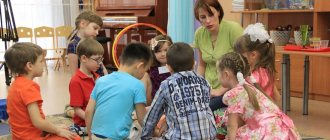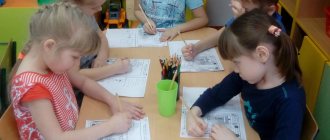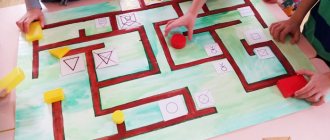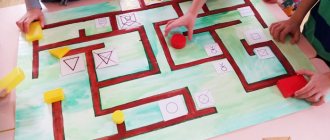How does a child’s communication change throughout preschool age?
The need for communication is inherent in human nature. But this need has many nuances. At different age stages, communication performs its actual functions. The nature and motives of communication change even at such a short stage as preschool childhood.
Firstly, the circle of people with whom the child interacts is gradually expanding. First of all, these are adults who explain, help, and protect everything. But then the preschooler’s interest in communicating with children like himself becomes more active.
Secondly, the subject matter of communication changes. Communication based on practical actions is being replaced by mental communication. If a 3-4 year old child reaches out to his interlocutor to show what a beautiful dress a doll has or talk about a new car, then a five year old child can spend hours asking his “Why?”, simply walking next to his mother.
No improvised objects or toys are needed to ask where the sun sets, what the rainbow is made of, or why the chicken doesn’t fly. And all this interests children so much.
The progress of communication in preschool age continues further, introducing new motives for the need to communicate with adults or peers. Having bombarded their parents with questions about natural phenomena and learned something for themselves, children strive to share their knowledge with their peers. And adults are addressed with the next batch of questions - now about people’s relationships, professions, hobbies and other human subtleties.
Communication is the best opportunity to get to know the surrounding reality and yourself. This is one type of activity, which is why it is called a communicative activity. Preschoolers are involved in this activity. They are guided by different motives. Forms of communication in preschool age acquire an extra-situational character, since the development of cognitive processes and speech allows the child to reason abstractly, and not just about what he sees and hears at a particular moment.
How to talk to children?
From the first days of his life, the baby needs to hear the speech of his parents (a lullaby at night, and constant dialogue during bathing, swaddling, feeding), this is a characteristic feature of everyone.
You need to communicate with children correctly
Important! The words remain in the baby's subconscious. What the little child was able to hear will help him speak on his own in the future.
Towards the end of the infant period, the baby tries to speak independently. Don't try to talk to him by pronouncing words the way he does. You need to adhere to the correct pronunciation.
In the preschool period, it is necessary to tell the story at the level of understanding, and not get away with phrases: “I’ll tell you when you grow up,” “it’s too early to know about it.” The child may take this as a reluctance to talk, they don’t like him.
Words must be pronounced clearly
Why talk to children?
A child needs communication from an early age, even when he cannot speak. It is necessary just like food and air.
It is useful to achieve successes, celebrate them with praise, talk about future plans, draw up a program of activities for the weekend and hang a reminder on the refrigerator, and talk about secrets.
Note! Without communication, a person who knows how to express desires, defend a position, and resolve issues in a team or family with the help of words, not force, will not grow up.
Talking to a newborn is just as necessary as talking to a preschooler. If a baby can’t speak, it doesn’t mean he doesn’t understand anything. By the intonation and timbre of the voice, he feels what emotional state mom or dad are in, and perceives the attitude towards him.
The role of communication with parents in the psychological development of preschool children
The leading method of communication is play. Parents can tell the rules in words. A preschooler can talk about the results, play the roles and feel the negative result. It is useful to study the technology of dough sculpting, develop motor skills, and conduct a drawing master class.
The role of communication between a child and his parents is enormous. With insufficient conversation, retarded development of speech, psyche, and a complex of self-doubt may develop. If the child does not talk, life guidelines are torn. Children copy their parents. The way the dialogue is staged in the family, what the tone is, how they speak about others in the presence of the child, all this will manifest itself in behavior among peers in kindergarten, on the street, in communication with the teacher.
The main communication is with parents
Rules for communicating with parents for children
There are rules for verbal interaction for children: respectfully and at the proper level. Parents want their children to be polite. When going to bed, they said (“Good night, mom and dad”), and when they woke up, they greeted (“Good morning”), so that requests were accompanied by the word “please,” and did not forget to thank (“thank you”), so that the request to “collect toys” was not provoked negative words in response, but was carried out without wrangling.
Classes on cognitive development in older groups
It is not enough for a child to have only the wishes of his parents. It is necessary to show how to respond to requests and greetings. And do this not as an “open lesson in cultural behavior,” but as an everyday consistency. An audiobook or online video will help you learn the secrets of communication.
Basic conditions for the development of communication in preschool age
Close people play a primary role in a child’s life, and the child’s involvement in communication depends on them. Unlike older children, any activity of preschoolers is directed by adults. The corresponding features of communication between preschool children are emerging:
- An adult gradually immerses the child in the knowledge and skills developed by many generations of humanity, and without which life is unthinkable.
- The child perceives adults as a model - how to behave, what feelings and qualities to show in various situations.
- When communicating with adults, the preschooler receives feedback in the form of support and praise.
- Communication with peers provides an opportunity for a child to get to know himself and realize that he is one of the same children.
Motives for communication among preschoolers
Let's find out what motives drive preschoolers when they initiate communication with an adult or peer. A 3-year-old child hands his dad parts of a construction set - this is already an invitation to interact. The 4-year-old “why” besieges his parents with questions about what and how. A 5-year-old preschooler sits his grandmother in a chair and declares that he will treat her. A 6-7 year old child declares that he will go play with Mishka, but he is not interested in playing with Vladik.
In any of these cases, a leading motive appears. , cognitive motives predominate . Children understand that adults can and know a lot, therefore, in addition to emotional attraction to adults, they are driven by cognitive interest.
In middle preschool age, children need play partners. They are attracted to story-based games that simulate everyday life.
And since the most efficient play partner is an adult, children love to involve the role of mothers, grandmothers and, less often, the male part of the family in playing the role. Let gaming activities take place, but business motives of communication predominate at this age.
Older preschoolers actively communicate with both adults and peers. They become selective in relation to their peers. They make friends with whom they are ready to play “mother-daughter”, football and any other game. But a category of children with whom they do not intend to communicate is also identified. And if you play in a team game, then on different teams. Personal motives come to the fore at this age stage .
6-year-old children also continue to approach adults with questions or a desire to hear evaluation and praise. Along with knowledge of the world, they are now often interested in issues of a moral nature. The motives for communication between preschool children and adults in such cases can also be attributed to personal ones.
Development of communication skills in preschool children
The communication need is special. It develops as a need to know oneself and other people. To satisfy this need, at least primary communication skills are important. What communication skills can we talk about at the age of 3-5 years?..
To guide your child in developing successful interactions, pay attention to how your child expresses himself when trying to communicate with similar kids. Communication among younger preschoolers is characterized by:
- Attention to a peer as someone “like myself.”
- Emotional perception of interaction with a peer.
- The desire to show oneself to one’s peers: what I can do, how I do it.
- Sensitivity and receptivity to how your little communication partner treats you.
All of the above components are important. When observing a child, it is easy for adults to notice what is present in abundance and what manifestations are completely absent. For example, if a preschooler is just demonstrating his achievements, you need to intervene and suggest: “Let’s see how a girl/boy can do...”, “You showed off your excavator, and now your friend wants to demonstrate how his cars drive.”
It is useful to regulate the emotional background of communication between preschoolers. For children who are frowning, their mood will be disturbed. Changes in emotions are facilitated by surprise. Figure out how to surprise the kids (by building an unusual tower, demonstrating the unobvious advantages of a familiar toy, etc.), and you will see how their mood will change positively and communication will begin.
If you instill a culture of interaction from early childhood, over time, younger preschoolers intuitively demonstrate such an important quality - paying attention to their communication partner. This is an opportunity to develop the child's communication skills.
Communication among older preschoolers is more multifaceted. After 5 years, children spend significant time with peers. They are connected by various activities that require communication.
This is a role-playing game, creativity, and productive activity. Interaction with others often takes the form of cooperation.
How successful the cooperation will be depends on each participant. In older preschool age, the development of communication skills is closely intertwined with the formation of moral qualities. Goodwill and attention to others, affability and friendliness, willingness to help each other and the ability to give in are qualities without which interpersonal relationships cannot be successful.
Consultation for parents
Teachers divide the preschool period into:
- Junior - from two to four years old.
- The average is four to five years.
- The eldest is from five to six years old.
Note! Communication, as the leading need of a preschooler, was noted by psychologists at the age of 2-4 years, and involves not only playing with children, but also conversation, naming objects, and memorizing a children's song.
Didactic games for visual arts in kindergarten
Middle age is rich in children's passions; a child can quarrel and make peace several times a day, and tries to show character in communication.
Old age is emotional. Kids say and do only what they want. Whatever the emotions, positive or negative, the main thing is that they are sincere. The child is able to distinguish the boundaries of behavior in a circle of friends, in the presence of adults, including speech behavior.
Parents need to remember that a preschooler among his peers and in his home circle are two different people. He understands that the way he expresses emotions among his peers cannot always be expressed in front of his parents. Parents should not take hostility to remarks about how unsightly he behaves with his peers in the garden, when at home he is quiet, modest and calm.
Verbal and nonverbal communication in the mental development of a child
In the mental development of a child, there are two types of communication: verbal and non-verbal.
Verbal means communication through speech. There are four types of speech activity:
- Speaking is the use of language to communicate verbally.
- Listening - understanding sound speech.
- Writing is the ability to record speech on paper.
- Reading is the perception of information from text on paper.
You can understand a lot by facial expressions
Nonverbal is communication without the use of speech. Kinds:
- sight;
- facial expressions;
- gestures.
Both types of communication are present in a child’s life; one cannot be completely separated from the other. The child makes faces, grimaces, parodies someone not only in conversation, but also in gestures. Both types of communication are necessary for a preschooler to be able to correctly express his thoughts.
Thematic literature for parents
Parents can get a lot of useful information about talking with a child and raising him from books.
Lisina's book
Particular attention should be paid to the book by M.I. Lisina “Communication with adults in children of the first seven years of life.” This book formulates in an easily accessible form such a concept as “communication”, its role in the formation of a child, motives, means, forms of communication, and the participation of adults in the formation of a more advanced form of communication.
Grishaeva's technique
Grishaeva’s methodology for developing communication should also not be ignored. Through thematic conversations using various cards, the author proposes to form a culture of communication in children when meeting, show forms of greeting, and form the child’s concept of goodness. Teach him to consciously show empathy and kindness to people around him, to distinguish between the deception of bad people, to treat things carefully, and to appreciate the work of strangers.
Thus, parents who are interested in raising a full-fledged personality from their child should remember that, first of all, by their behavior and communication in the family circle, they show the child’s model of communication in society.
Forms of communication between children and adults
Communication with adults is, in essence, interactions in the “zone of proximal development,” since a preschooler uses his potential and fills in the blank spots in his knowledge.
Starting from the age of 3, the baby becomes an active explorer of everything around him.
The need for cognitive activity and the desire to get answers to puzzling questions directs him to his parents or other significant adults. Interaction takes on an extra-situational character and is realized in two forms of communication that follow each other.
Extra-situational-cognitive communicative form
Communication can be situational in nature, and the child may ask to draw the same bunny that he has in his hands. But increasingly, interest goes beyond situations. The preschooler asks where the bunny lives, if he has a house, and immediately continues to ask questions about all the animals he knows.
An adult is an expert for a child who knows everything and can do everything. The kid accepts any answer. Often these answers are presented in a fantasy or fairy tale context. And how else can a child answer the question in style, does the Bear sing songs to her Little Bear?.. Nevertheless, the preschooler satisfies his current cognitive interest.
Cognitive communication with an adult gives the child real ideas about the world and expands his understanding of the cause-and-effect relationships between surrounding objects and phenomena.
Extra-situational-personal form of communication
The older a preschooler gets, the more he understands that the social environment is much wider and more diverse than his usual environment. The child realizes that he needs to learn how to behave and act correctly in different situations. Moreover, he sees the different behavior of his peers, which leads him to the conclusion that not everyone behaves as they should.
The preschooler has questions for elders in order to understand the meaning of relationships between people. To some extent, the older preschooler checks his point of view to see whether it coincides with the position of the adult. This is how generally accepted social norms are assigned.
By talking with adults, the child learns standards of expression and behavioral cultural norms. The preschooler begins to develop his own authorities. To understand a certain situation, he increasingly turns to the adult whom he considers most competent in this matter.
Communication: essence of the concept and types
Definition 1
Communication is the process of establishing and subsequently developing contacts between people, generated by their need for joint activities and including the exchange of information, mutual perception, and attempts to influence each other.
Note 1
Without communication, no human activity is possible.
Communication has content that is revealed in two interrelated aspects:
- Communication acts as a process that does not imply influencing changes in the psychological state of the partner. In this case, communication is used to establish and subsequently develop contacts between people. Moreover, this contact is based on joint activities or human needs.
- Communication acts as a process aimed at changing the psychological state of the partner. In this case, communication is used to change the behavior of the interlocutor, his personal and semantic formations.
Are you an expert in this subject area? We invite you to become the author of the Directory Working Conditions
The following types of communication are distinguished, depending on its means:
- Verbal communication is communication carried out through speech, providing a person with extensive communicative capabilities.
- Nonverbal communication is communication carried out through gestures, facial expressions and pantomimes, as well as through bodily or sensory contacts.








